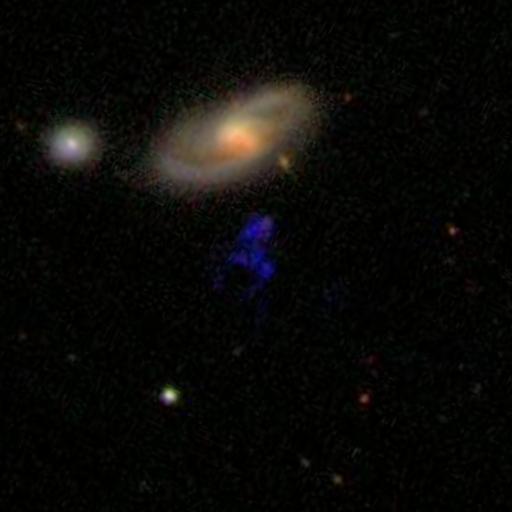Back a few month's ago, we had an article about
Galaxy Zoo
. In essence, it's a type of consortium that studies galaxies and works towards classifying them. In the process of studying the images, they made a rather unusual discovery... One that's still around.
According to the
Galaxy Zoo
blog: "Ever since it was first identified, Hanny's Voorwerp has grabbed the attention of the Zookeepers and everyone else who comes across it. One reason we've been successful in getting such a wide range of observations over just a few months (and therefore why posts on here have been delayed!) has been that colleagues seem to find it equally compelling. So what is it? Our current best guess goes something like this:
A hundred thousand years ago, a
quasar
blazed behind the stars which would have already looked recognizably like the constellation Leo Minor. Barely 700 million light-years away, it would have been the nearest bright quasar, shining (had anyone had a telescope to look) around 13th magnitude, several times brighter than the light of the surrounding galaxy. This galaxy, much later cataloged as IC 2497, is a massive spiral galaxy which was in the process of
tidally shredding
a
dwarf galaxy
rich in gas - gas which absorbed the intense ultraviolet and X-ray output of the quasar and in turn glowed as it cooled. But something happened to the quasar. Whether it turned off, dropped to a barely simmering level of activity as its
massive black hole
became starved for gas to feed its accretion, or it was quickly shrouded in gas and dust, we don't see it anymore. But we see its echo."
But that was months ago. Is Hanny's Voorwerp still alive and kicking? You betcha'. Astrophotographer Joe Brimacombe took this week's image of the Voorwerp (Dutch for "what the heck is that?") on May 25, 2008. Like Joe's own interest,
Galaxy Zoo
didn't stop searching out the meaning of Hanny's Voorwerp, either. They kept right on photographing and analyzing. According to Bill Keel:
"At this point, we know that the object is rich in highly ionized gas. There is
continuum light
, especially at the northern tip, but the emission lines are so strong that we can as yet say little about its continuum structure. The high ionization might suggest shock ionization or photoionization by an
active galactic nucle
i, which would have to be much brighter than any we see in the neighborhood. If the AGN is in IC 2497, it must be highly obscured from our direction but not toward the gas. (It may be significant that the cloud lies near the galaxy's projected minor axis). The FIRST survey at 20 cm shows weak emission from the cloud and a significant
radio source
in IC 2497. We are now pursuing further imaging, UV, and X-ray detections to work out what we are seeing here. Whatever it is, it seems to be unique in the SDSS imaging survey. Chris Lintott has queried the database and, after winnowing out imaging artifacts, found no objects with u-g and g-r colors within 0.15 magnitude of what we see in Hanny's Voorwerp.
Our working hypothesis is that Hanny's Voorwerp consists of dust and gas (maybe from a tidally disrupted dwarf galaxy) which is illuminated by a
quasar outburst
within IC 2497, an outburst which has faded dramatically within the last 100,000 years."
What ever it might truly be is still somewhat a mystery... But it's a great summer-hot object!
Image credits of Hanny's Voorwerp belong to Galaxy Zoo and Joe Brimacombe.
 Universe Today
Universe Today
